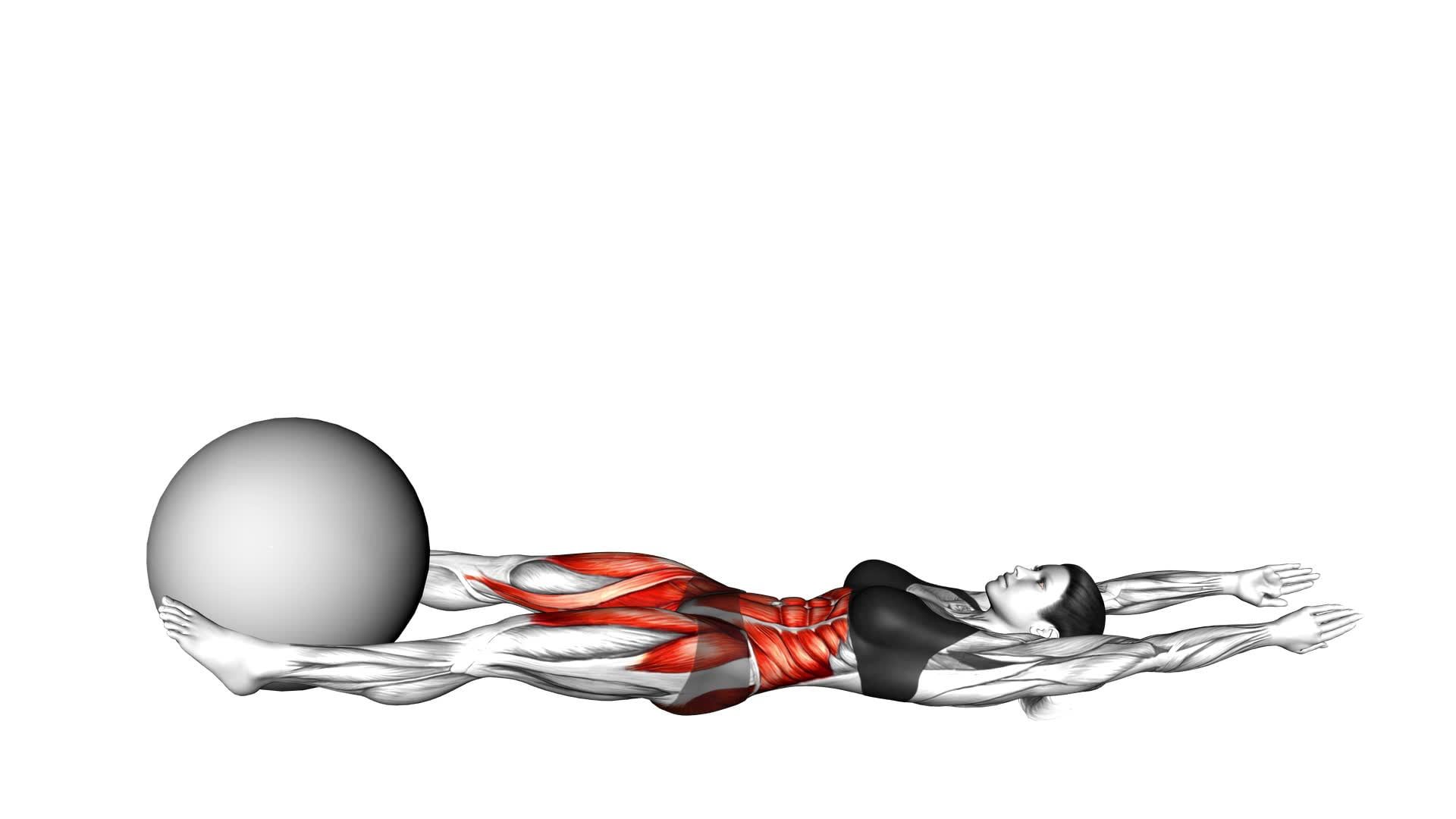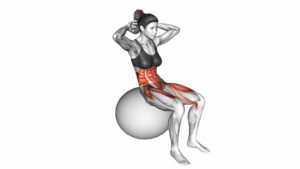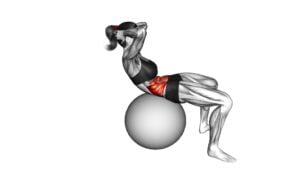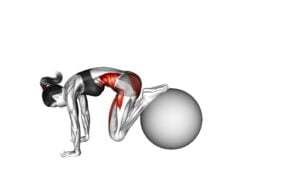V-Up-Down (With Stability Ball) (Female) – Video Exercise Guide & Tips

Are you looking for a challenging workout that targets your core muscles? Look no further than the V-Up-Down exercise.
Watch This Exercise Video
This video exercise guide and tips will show you how to perform this exercise with a stability ball. Get ready to engage your abs and improve your stability as you follow along with the female demonstrator.
Whether you're a beginner or an experienced fitness enthusiast, there are modifications and advanced variations to suit your fitness level.
Get ready to take your workout to the next level!
Key Takeaways
- The V-Up-Down exercise improves core strength and stability.
- Incorporating a stability ball can add instability and increase the challenge of the exercise.
- Adding resistance through weights or resistance bands can further increase the intensity of the exercise.
- Consistently performing the V-Up-Down exercise can lead to a strong and stable core, improved physical performance, and injury prevention.
Benefits of the V-Up-Down Exercise
You can experience significant improvements in core strength and stability by incorporating the V-Up-Down exercise into your fitness routine. The importance of core strength can't be overstated, as it serves as the foundation for all movement in the body. A strong core not only enhances athletic performance but also helps prevent injuries and improves posture.
The V-Up-Down exercise targets the abdominal muscles, including the rectus abdominis, obliques, and transverse abdominis. It also engages the hip flexors and lower back muscles. By consistently performing this exercise, you can develop a strong and stable core.
To progress the V-Up-Down exercise, you can start by performing it without any added resistance. Once you have mastered the basic movement, you can increase the challenge by incorporating a stability ball. Placing your feet on the ball while performing the exercise adds an element of instability, forcing your core muscles to work harder to maintain balance.
Another way to progress the exercise is by adding a weight or resistance band. Holding a dumbbell or medicine ball while performing the V-Up-Down increases the resistance and demands more strength from your core muscles.
Incorporating the V-Up-Down exercise into your fitness routine won't only help you achieve a stronger and more stable core but also contribute to overall improved physical performance.
Proper Form and Technique
To perform the V-Up-Down exercise with proper form and technique, focus on maintaining a stable core and controlled movements throughout the exercise. Here are some key points to keep in mind:
- Common Mistakes:
- Avoid using momentum to perform the exercise. Instead, rely on your core strength to lift your upper body and legs.
- Don't allow your lower back to arch excessively during the movement. Engage your abdominal muscles to maintain proper alignment.
- Resist the urge to rush through the exercise. Slow and controlled movements will yield better results and reduce the risk of injury.
- Muscle Groups Targeted:
- The V-Up-Down exercise primarily targets the abdominal muscles, including the rectus abdominis (six-pack muscles) and the obliques.
- It also engages the hip flexors, which play a crucial role in stabilizing the core and assisting with the movement.
Equipment Needed for the Workout
To perform the V-Up-Down exercise with proper form and technique, you'll need a stability ball. A stability ball, also known as a Swiss ball or an exercise ball, is a versatile piece of equipment that can enhance your workout routine.
There are different types of stability balls available in the market, such as burst-resistant and anti-burst balls. The burst-resistant ones are made from a material that prevents them from popping if punctured, providing an added layer of safety.
The prices of stability balls can vary depending on the brand and quality. You can find them at various price points, ranging from around $10 to $50. It's important to choose a stability ball that suits your height and weight, as this will ensure proper support and stability during your exercises.
When purchasing a stability ball, make sure to check the weight limit and size recommendations provided by the manufacturer. Investing in a high-quality stability ball will ensure durability and longevity, making it a worthwhile addition to your fitness equipment collection.
Modifications for Beginners
If you're new to the V-Up-Down exercise with a stability ball, it may be helpful to start with modified variations. These modifications are designed to make the exercise more accessible for beginners while still targeting the core muscles effectively. Here are some beginner modifications to consider:
- Use a smaller stability ball: If you find it challenging to maintain balance on a regular stability ball, try using a smaller ball. This will provide more stability and make it easier to perform the exercise with proper form.
- Bend your knees: Instead of fully extending your legs during the exercise, you can bend your knees to make it less demanding on the core muscles. This modification allows you to gradually build strength and stability before progressing to the full exercise.
When performing the V-Up-Down exercise, it's important to be aware of common mistakes that beginners often make. These include:
- Using momentum: Avoid swinging your body or using momentum to lift yourself up. This takes away the focus from the core muscles and reduces the effectiveness of the exercise. Instead, engage your core and use controlled movements throughout.
- Straining your neck: It's common to strain the neck by pulling on it or tucking the chin too tightly. Keep your neck relaxed and in line with your spine to avoid unnecessary strain and potential injury.
Advanced Variations for Experienced Fitness Enthusiasts
Once you have mastered the beginner modifications, you can take your V-Up-Down exercise to the next level with advanced variations for experienced fitness enthusiasts.
These advanced modifications will challenge your core strength and stability even further, helping you to achieve greater fitness gains.
One challenging variation you can try is the weighted V-Up-Down. Instead of using just your body weight, hold a dumbbell or medicine ball in your hands as you perform the exercise. This added resistance will increase the intensity and engage your muscles even more.
Another challenging variation is the single-leg V-Up-Down. Start by lifting one leg off the ground as you perform the exercise, focusing on maintaining balance and control. This variation will target your core muscles and also work on your balance and coordination.
Lastly, you can try the V-Up-Down with a twist. As you come up into the V position, rotate your torso to one side and touch the stability ball with your hand. Alternate sides with each repetition to engage your oblique muscles.
These advanced modifications will push your limits and help you achieve a stronger core and improved overall fitness.
Tips for Getting the Most Out of the Exercise
To maximize your results and get the most out of the V-Up-Down exercise, focus on maintaining proper form and engaging your core muscles throughout the entire movement. Here are some tips to help you optimize your performance:
- Maintain proper form:
- Keep your back straight and shoulders relaxed.
- Engage your core by pulling your belly button towards your spine.
- Control your movements:
- Lower your legs and upper body slowly and with control.
- Avoid using momentum to swing your body up and down.
- Breathe properly:
- Exhale as you lift your legs and upper body off the ground.
- Inhale as you lower them back down.
- Avoid common mistakes:
- Don't strain your neck by pulling on it with your hands.
- Avoid arching your lower back excessively.
- Modify the exercise if needed:
- If you find it difficult to perform the exercise with straight legs, bend your knees slightly.
- If balancing on the stability ball is challenging, start by practicing on a stable surface before progressing to the ball.
Frequently Asked Questions
How Many Calories Does the V-Up-Down Exercise Burn?
The v-up-down exercise is a great way to tone your abs and burn calories. By incorporating variations of this exercise, such as using a stability ball, you can increase the intensity and engage more muscles.
While it's difficult to determine the exact number of calories burned during this exercise, it's generally considered a high-intensity movement that can contribute to weight loss when combined with a balanced diet and regular exercise routine.
Can the V-Up-Down Exercise Help Improve Posture?
The v-up-down exercise can definitely help improve your posture. By targeting your core muscles, it strengthens them, which in turn supports your spine and helps you maintain proper alignment.
This exercise also promotes stability and balance, further enhancing your posture. Additionally, there are variations and modifications available for different fitness levels, allowing you to tailor the exercise to your needs and gradually progress as you get stronger.
Is It Necessary to Warm up Before Doing the V-Up-Down Exercise?
Yes, it's necessary to warm up before doing the V-Up-Down exercise. Warming up helps prepare your body for the workout by increasing blood flow and loosening up your muscles. It reduces the risk of injury and improves your performance.
Incorporating a stability ball in the V-Up-Down exercise provides added benefits, such as increased core engagement and stability.
Beginners can modify the exercise by using a smaller range of motion, while advanced individuals can progress by adding weights or increasing the intensity.
How Often Should the V-Up-Down Exercise Be Performed to See Results?
To see results from the v-up-down exercise, it's important to perform it consistently. The frequency of this exercise depends on your fitness level and goals. Generally, aim to do it 2 to 3 times a week. However, keep in mind that individual results may vary.
It's also beneficial to incorporate variations of the v-up-down exercise, such as using a stability ball or adding weights, to challenge different muscle groups and prevent plateaus.
Are There Any Precautions or Contraindications for Individuals With Certain Medical Conditions When Performing the V-Up-Down Exercise?
When performing the V-Up-Down exercise, it's important to take precautions if you have certain medical conditions. Always consult with your healthcare provider before starting any new exercise routine.
Individuals with conditions such as back or neck injuries, hernias, or abdominal separation should approach this exercise with caution. It's best to modify or avoid the exercise altogether if it causes pain or discomfort.
Your safety and well-being should always be the top priority when engaging in physical activity.
Conclusion
In conclusion, the V-Up-Down exercise is a challenging and effective workout that targets the core muscles.
By using a stability ball, you can add an extra level of difficulty and engage more muscles.
It's important to maintain proper form and technique throughout the exercise to avoid injury and maximize results.
Whether you're a beginner or an experienced fitness enthusiast, there are modifications and advanced variations available to suit your fitness level.
Remember to follow these tips to get the most out of your V-Up-Down exercise.

Author
Years ago, the spark of my life’s passion ignited in my mind the moment I stepped into the local gym for the first time. The inaugural bead of perspiration, the initial endeavor, the very first surge of endorphins, and a sense of pride that washed over me post-workout marked the beginning of my deep-seated interest in strength sports, fitness, and sports nutrition. This very curiosity blossomed rapidly into a profound fascination, propelling me to earn a Master’s degree in Physical Education from the Academy of Physical Education in Krakow, followed by a Sports Manager diploma from the Jagiellonian University. My journey of growth led me to gain more specialized qualifications, such as being a certified personal trainer with a focus on sports dietetics, a lifeguard, and an instructor for wellness and corrective gymnastics. Theoretical knowledge paired seamlessly with practical experience, reinforcing my belief that the transformation of individuals under my guidance was also a reflection of my personal growth. This belief holds true even today. Each day, I strive to push the boundaries and explore new realms. These realms gently elevate me to greater heights. The unique combination of passion for my field and the continuous quest for growth fuels my drive to break new ground.







